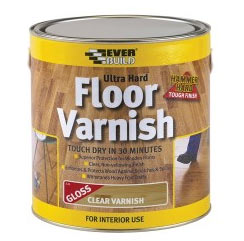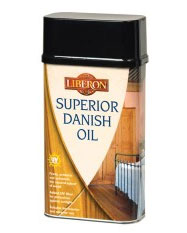See also our project on replacing a timber floor, our project on sanding a timber floor and also our project on filling gaps in floorboards.
Sealing a Timber Floor
Nearly all timber floors need sealing. The natural beauty of the wood is highlighted, dirt and spores cannot get ingrained, cleaning is easier and the timber is protected.
There are many ways to seal a timber floor, and some methods require a mixture of other methods. Some timbers require far more care than others for a seal to be effective.
Teak is very oily and should be washed with solvent prior to sealing. This may not stop the oil completely but will remove as much as possible. The same method of preparation applies to timbers with high resin content, namely Gurjun (East Indian timber who’s oils are used as fragrances and even skin diseases such as leprosy) and Douglas Fir.

iberon floor cleaner
Parquet and Woodblock Flooring
Parquet flooring and woodblock flooring should always be treated with an application of liquid solvent wax before any of the non-breathing seals (varnishes) are used.
Timber floors move, and if movement happens within the small blocks, rafting will occur if some kind of lubrication is not present and the blocks are stuck together with the seal.
Once this floor wax is dry, it should be sanded carefully from the surface when sealing can be applied. When sealing an existing floor, all existing waxes and varnishes should be removed. Some do not work with others and a reaction may result in the new seal not drying and/or sticking correctly.
Varnishes for Timber Floors
It is generally accepted these days that a varnish of some kind is the best seal for a floor. This is largely because we now use all of the rooms in our homes and the floor is subject to quite a bit of traffic.
The most common varnishes are polyurethane. Solvent-based polyurethane dominated the market for some time until more “user friendly” acrylic and polyurethane acrylate water based seals became available.
Solvent based varnish takes an age to dry but the water based alternatives can be over-covered in 3 to 4 hours sometimes, and if you get up early enough you can do the required 2, or even 3 coats in a day!
Preparing for varnish on a new, or newly sanded floor, involves a very thorough hoover, then a mop down with a damp mop, or even better a rub over with a rag dipped in white spirit. The spirit evaporates quickly and varnishing can begin in a dust free environment.
A water-based clean of a floor must be completely dry or it will cause the surface to go “milky and bubbly” when the varnish is applied. All varnishes will alter the colour of the timber slightly. This is because they will reflect and refract the light differently into the grain of the wood, and the colour of that wood will be emphasised.
Varnish is available in degrees of durability. There are “rock hard” varnishes for very heavily used floors and even for commercial use as well as light use varnishes. Varnishes are generally available in a matt, satin and gloss finish.
In general satin or matt finishes are the prefered choice for a floor, whereas gloss finishes tend to reflect light quite a bit and cause far too much glare and reflection.

Everbuild Ultra Hard Floor Varnish
Waxes for Timber Floors
Wax will extend the life of a sealed floor a great deal. It should be used regularly and buffed to a shine but removed from time to time with a neutral detergent to avoid a build up. No caustic solutions should be used on a timber floor.
Wax can be used on timber floors without sealing them. In this case a solvent-based wax is better, rubbing well into the grain and buffed with an electric polisher. The wax can be mixed with a little white spirit for the first coat, and rubbed into the grain further and more easily. The buffing helps the wax get further into the pores and also hardens the surface to give it a lasting finish.
If this method is adopted, once the surface of the solvent based wax is buffed and hard, it is preferable to give regular maintenance using a solvent based liquid wax. This spreads more easily and leaves a thinner film. This should also be buffed hard with each, dry application.
Wax can come in several colours, mostly used to give an “antique” look. It will restore a more natural beauty to the wood than varnish but it will not give anywhere near as hard a surface and will need regular maintenance to stay in top condition.
If the floor has been sealed with water based seal, then only water based waxes should be used. If you use a solvent on a water-based seal it may damage it. If the seal is solvent based, the wax is a matter of personal preference.

Briwax Wax Polish Original Rustic Pine
Button Polish for Timber Floors
So called because it is made from shellac resin, which is an alcohol-based resin melted into thin flakes and resembling buttons and is then mixed with methalated spirits.
This finish is applied in, generally, two coats – the first is applied quite thickly and rubbed into the grain well. The second, a thin layer, applied after the first is dry. This sinks well into the timber giving a reasonably hard finish, which is water resistant.
Button polish damages and scratches easily and should always be protected by wax if chosen as the floor finish.

Rustins Button Polish
Oils for Timber Floors
Oils have traditionally been used to protect timber for generations and there are many types to choose from.
Floor oils are seldom used these days as they trap dust dreadfully and leave the surface looking dirty most of the time. It is for this reason that floor oils are used sometimes in areas where it is essential that the air remains as dust free as possible!
Oils generally will harden the surface fibres of the timber and will improve the durability of the floor, sinking quite deep, comparatively, into the grain protecting the timber and enhancing, although slightly darkening, the grain.
Overall though, the timber will remain “soft” if treated with oil and it is not recommended for areas with high foot traffic.
Maintenance is fairly easy, rubbing over with a scourer and re-oiling when the floor goes dull, which it often does! Click on the images for oils.

Rustins Floor Oil

Everbuild Teak Oil

Liberon Superior Danish Oil

Everbuild Raw Linseed Oil
Stains for Timber Floors
Stains can be applied to most timbers. A water based stain should be used to get a more even and natural looking finish. Test stains on an offcut of timber first as it is too late after its on your floor.
Finishing and sealing products should be checked for compatibility with the stain used. Test for this and if in doubt consult the manufacturer of the finishing product.

Wood Dye and Stain

